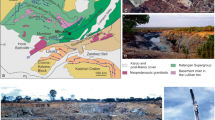Abstract.
The Maronia copper-molybdenum deposit is hosted by a porphyritic microgranite, located 30 km south-east of Komotini in Thrace (north-eastern Greece) in the Rhodope metallogenic province. The geology of the area is dominated by metamorphosed Mesozoic sedimentary and volcanic rocks, and Tertiary plutonic and subvolcanic intrusions. The metamorphic rocks belong to the Makri Unit of the Circum Rhodope Belt and consist mainly of marbles and calc-schists in the lower part and schists in the upper part. The marbles and schists of the Makri Unit are intruded by the Oligocene Maronia pluton of gabbroic-monzogabbroic-monzonitic composition and a younger porphyry microgranite, which is the host of the copper-molybdenum mineralisation. Three hydrothermal alteration zones have been recognised in the porphyritic microgranite: an argillic zone, a phyllic zone, and a propylitic zone which extends into the surrounding rocks. Additionally, three highly silicified zones crop out at the north-eastern, south-eastern and southern parts of the microgranite. Chalcopyrite-pyrite-molybdenite mineralisation, concentrated mainly in the silicified zones and associated with areas of phyllic and propylitic alteration, occurs as disseminations, veinlets and segregations. Surface samples of altered rock contain as much as 7,600 ppm Mo, 5,460 ppm Cu and 1 ppm Au. Geochemical data from a drill core revealed a 10-m-thick horizon containing as much as 12 ppm Au, 17 ppm Ag and 2.00% Cu. Argillic and phyllic alteration zones are characterised by relatively low REE abundances (average total: 88 and 95 ppm respectively) and negative Eu anomalies, compared to rocks in the propylitic alteration zone where REE contents are higher (average total: 177 ppm) and there is a positive Eu anomaly. The ore-related mineral assemblage consists of sulphides (pyrite, chalcopyrite, cubanite, pyrrhotite, pentlandite, molybdenite, sphalerite, galena and bismuthinite), sulphosalts (tetrahedrite, tennantite, zinkenite, chalcostibite, famatinite, bournonite, boulangerite, meneghinite) and oxides (magnetite). The molybdenites revealed unusually high and variable rhenium concentrations, from 0.12 to 4.21 wt%. Microthermometric investigation of four types of fluid inclusions in ore-related quartz revealed salinities from 5 to 55 wt% NaCl equiv, with homogenisation temperatures varying mainly from 280 to 460 °C. The application of the chlorite geothermometer yielded temperatures between 308 and 331 °C for lowest-temperature propylitic alteration. The estimated trapping pressures of the ore-forming fluids range from 150 to 510 bar. Boiling is considered to be the main process of ore formation. Sulphur isotopic compositions for the pyrite and molybdenite suggest an igneous derivation of sulphur. Ascending melts and hydrothermal fluids interacted with the sulphide-bearing metavolcanic rocks, incorporating sulphur and ore metals (including Cu, Mo, Pb, Zn and Au) from the lithosphere. Geological, mineralogical and geochemical data indicate that the Maronia deposit has the potential of containing economic quantities of exceptionally high-grade porphyry Cu-Mo ores, with economic gold grades, in an easily accessible, yet under-explored region.
Similar content being viewed by others
Author information
Authors and Affiliations
Additional information
Electronic Publication
Rights and permissions
About this article
Cite this article
Melfos, V., Vavelidis, M., Christofides, G. et al. Origin and evolution of the Tertiary Maronia porphyry copper-molybdenum deposit, Thrace, Greece. Mineralium Deposita 37, 648–668 (2002). https://doi.org/10.1007/s00126-002-0277-4
Received:
Accepted:
Published:
Issue Date:
DOI: https://doi.org/10.1007/s00126-002-0277-4




